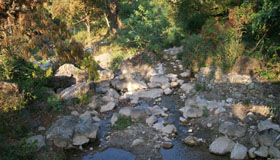Yog/Yoga aasan/ Anatomy & Philosophy
Yoga is for everyone. It doesn't matter if someone has a flexible body or not. Yoga is a peaceful and energetic lifestyle. Yoga is a combination of nutrition, physical exercises (asanas), breathing exercises (pranayama), meditation, relaxation and philosophical, positive thinking. The techniques of yoga sharpen your perception of what is essential in life. We recommend the old traditional yoga and do not believe in the commercial yoga lifestyle. Of course, we combine traditional knowledge with findings from current science. Above all, values are important to us. Traditional yoga supports basic human values and is not about financial profit. The most important thing is that everyone can learn and live yoga. So if your heart pulls you in this direction, you are always most welcome!
The basics and fundamental ideas about the ancient Indian yoga asanas, philosophy and mantra chanting with anatomy, metaphysics and physical science.
This is natural and traditional Himalayan yog. We designed a series for go deep and deep from begins. You can learn easily survive the life and balance the stress and emotions with your ambition of life. Whatever food nature give to us is Ayurveda. That's organic food.
Survive with nature and maintain of the nature is an art, a lifestyle. And this art and life style called yoga.If you like and feel really need fit natural with nature for good health and balanced mind . Please confirm to your space.
Brief discription:
1. Introduction
1.1. Fundamental Education: About Yoga
1.2. About Lead Teachers
1.3. About Ancient Yoga
2. Overall Learning Objectives
2.1. Traditional yogic culture
2.2. Ancient yogic daily life style
2.3. Meditation
2.4. Mantra chanting
2.4. Yog nidra
2.5. Yogic connection with nature and ethics.
3. Yoga Philosophy
3.1. Origin of Yoga
3.2. Ashtanga Marga: The 8 Limbs of Yoga
3.3. The Yoga Sutras of Patanjali
3.4. Spread the ancient value of Yoga with modern yoga and human values
3.5. Introduction about the kinds of yoga (Teacher training also available on each kind of yoga given below):
Raj yoga
Ashtang yoga
Hath yoga
Laya yoga
Dhyan yoga
Bhakti yoga
Kriya yoga
Mantra yoga
Karma yoga
Gyan yoga
Brahm yoga
3.6. Shrimad bhagvad gita
3.7. Aadi shankra charya ji
3.8. Swami vivekanand ji Others Rishi and muni
3.9. Ramayan, Upnishadas, Vedas and others ancient Indian history and philosophies Introduction.
4. Asanas and Asana analysis; i.e.;
4.1. Standing Poses
4.2. Backbends
4.3. Inversions
4.4. Seated Poses: Part 1 and part 2
4.5. Supine Poses
4.6. Restorative Poses
4.7. Surya Namaskar
4.8. Arm Balances
4.9. Use of Props
4.10. Adaptive Alignment
5. The Art and Science of Sequencing
5.1. Hatha and Vinyasa Style
5.2. Themed Sequencing
5.3. Sequencing for different bodies
6. Pranayama: The Art of Breathing
7. Meditation and Chanting
8. Anatomy and Physiology
8.1. Anatomy of bones, muscles, joints, and fascia.
8.2. Body movement.
8.3. Subtle bodies
9. Teaching Methodology
9.1. Communication Skills
9.2. Teaching Styles
9.3. Qualities of a yoga teacher
10. Therapeutic Yoga – for injury and joint health
11. Lifestyle and Ethics for Yoga Teachers
12. The line between yoga and Business of Yoga
13. Ayurveda science for daily life
13.1. Nature of body with herbs
13.2. Ayurveda for yogi and yogini
13.3. Yoga practice according to ayurveda.
14. Assignments and Practicum
15. Practice
16. Ritual introduction
17. Astrology Introduction and its effects
Contact us





























